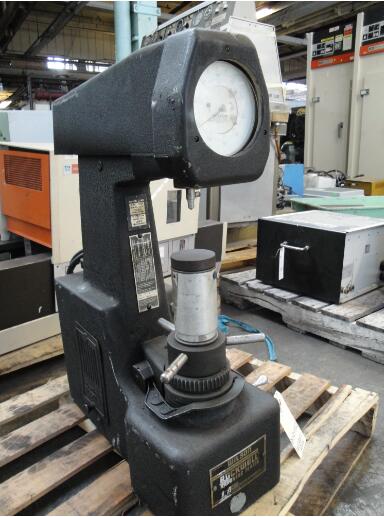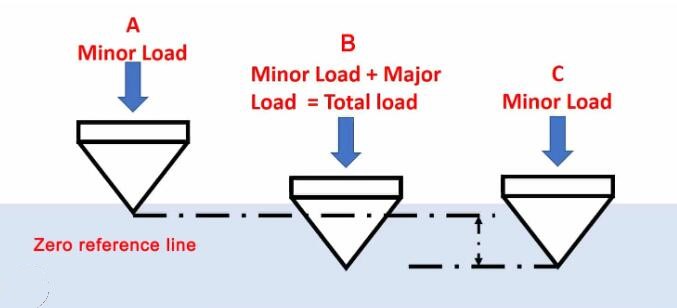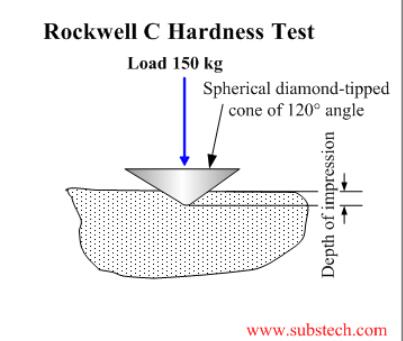In the ever-evolving world of manufacturing and materials science, the quality, durability, and reliability of material are paramount. To ensure these properties, experts leverage various tests, one of which is the Rockwell hardness test.
The Rockwell hardness test, often simply referred to as the Rockwell test, is a quick and reliable method to gauge the hardness of different materials. It’s widely utilized in industries ranging from automotive and aerospace to construction and electronics. But what makes this test so vital? How does it work? And why should businesses, like our own Chengli Hardware, pay attention to it?
Let’s dive into the fascinating world of Rockwell hardness testing!
Overview About The Rockwell Hardness Test

The Rockwell hardness test is a vital testing procedure used to measure the hardness of materials. But what exactly is hardness? In simple terms, hardness is the ability of a material to resist deformation, indentation or penetration. The harder the material, the less prone it is to dents and wear.
What is the Rockwell Hardness Tester?
At the heart of the Rockwell hardness test is a device called the Rockwell hardness tester. This machine is designed to exert a specific load onto the surface of the material being tested, using a specific indenter. The two types of indenters used are a diamond cone (also known as a Brale indenter) and a hardened steel ball.
The choice of indenter depends on the type of material being tested. For example, for harder materials like steel, a diamond cone indenter is often used. On the other hand, softer materials such as aluminum or brass are commonly tested using a steel ball indenter.
The Rockwell hardness tester measures the depth of the indentation left by the indenter, which is then used to calculate the Rockwell hardness number. This is where the term Rockwell hardness comes from.
Rockwell Hardness and Rockwell Units
The outcome of a Rockwell hardness test is a dimensionless number known as the Rockwell hardness number. This number signifies the hardness of the material, with a higher number indicating a harder material. Rockwell hardness numbers can be denoted in different scales, represented by different letters (A, B, C, etc.), depending on the combination of load and indenter used.
For example, when testing hardened steel with a diamond cone indenter, we use the Rockwell C scale, denoted as HRC. In contrast, softer materials like aluminum tested with a steel ball indenter are measured on the Rockwell B scale, or HRB.
Understanding the differences between these scales and what they signify is vital when interpreting Rockwell hardness values. But before we delve into that, let’s take a look at how the Rockwell hardness test is carried out.
The Rockwell Hardness Test Procedure

Knowing how a Rockwell hardness test is performed will help you better understand its precision and why it’s the preferred method for many professionals in the industry. The steps for conducting a Rockwell hardness test are as follows:
Sample Preparation: The material’s surface to be tested must be clean and smooth to ensure accurate readings. This often involves grinding and polishing the sample surface.
Selection of Indenter and Scale: The correct indenter (diamond cone or steel ball) and scale (Rockwell A, B, C, etc.) are chosen based on the expected hardness of the material.
Initial Load Application: The sample is placed on the anvil of the Rockwell hardness tester, and the indenter is brought into contact with the material’s surface. An initial minor load is applied. This establishes a zero-reference position.
Major Load Application: A major load is applied on top of the initial minor load, causing the indenter to penetrate deeper into the sample. The major load is held for a standardized period to allow for any material flow.
Major Load Removal: The major load is then removed, leaving only the minor load. This allows the material to partially recover, reducing the indentation depth.
Measurement: The depth of penetration from the zero-reference position (established after applying the minor load) to the final position (after removal of the major load) is measured. The difference in depth is used to calculate the Rockwell hardness number.
It’s important to note that a key advantage of the Rockwell hardness test is that the hardness value is read directly from the Rockwell hardness testing machine, making the procedure quick and straightforward.
Understanding Rockwell Hardness Numbers
Once you’ve conducted a Rockwell hardness test and obtained a Rockwell hardness number, it’s essential to understand what this number represents and how it can impact the suitability of a material for specific applications.
Breaking Down Rockwell Hardness Numbers
The Rockwell hardness number comprises a numeral and a letter — the numeral indicates the hardness of the material, while the letter represents the Rockwell scale used during testing. The most common scales are B and C. For instance, a Rockwell hardness of 60 C (notated as 60 HRC) is substantially harder than a Rockwell hardness of 60 B (notated as 60 HRB).
So, what does it mean when a material has a Rockwell hardness of 60? If we’re talking about 60 HRC, the material is considered very hard and suitable for high-stress applications. In contrast, a material with a Rockwell hardness of 60 HRB would be softer and more malleable, which could be ideal for applications where the material needs to be formed or shaped.
The Significance of HRC Values

HRC, or Rockwell C Hardness, is typically used for hardened materials like steel. When a steel material has a hardness of 55 HRC (55 HRC), it’s considered to be quite hard and can withstand a lot of wear and tear. It might be used in applications like cutting tools or high-impact machinery parts.
Similarly, a material with a hardness of 57 HRC is even harder, able to withstand even higher stress and wear. This could be used in more extreme applications like drilling equipment for oil and gas or high-performance engine parts.
Rockwell B or C: Which is Harder?
Rockwell C is much harder than Rockwell B. A material tested on the Rockwell C scale has been subjected to a heavier load and a diamond cone indenter, suitable for harder materials like hardened steel or cast iron. In contrast, the Rockwell B scale is for softer materials like aluminum, brass, and softer steels, which have been tested with a lighter load and a steel ball indenter.
Practical Applications: Rockwell Hardness in Different Materials

Understanding Rockwell hardness numbers becomes significantly more impactful when we look at their practical applications. Different materials, depending upon their hardness, find usage in various industries, each with specific needs and requirements.
Hardness in Metals: Steel, Brass, Aluminum, and More
Different metals have varying Rockwell hardness values which define their suitability for certain applications:
Steel: Often tested on the Rockwell C scale, hardened steel can exhibit high hardness levels. For instance, high-speed steel used in cutting tools might have a Rockwell hardness around 65 HRC. On the other hand, mild steel used in construction might have a hardness of around 55 HRB on the Rockwell B scale.
Brass and Bronze: These softer metals are generally tested on the Rockwell B or F scales. Typical hardness might range from 55 to 95 HRB, suitable for applications like decorative items, electrical connectors, and bushings.
Aluminum: Aluminum and its alloys have hardness values around 40-70 HRB, ideal for lightweight structures, aircraft parts, and beverage cans.
The Hardest Materials: Diamond and Hardened Steel
The highest Rockwell hardness is exhibited by diamond, the hardest known material on Earth, but it’s not a common material for industry use. In terms of industrially significant materials, hardened tool steels and high-speed steels can reach up to 67 HRC, utilized in high-stress environments like drilling or cutting operations.
Rockwell Hardness in Our Manufacturing Processes at Chengli Hardware
At Chengli Hardware, we recognize the importance of Rockwell hardness in determining the suitability of materials for different manufacturing processes. For example, in our metal stamping operations, understanding the hardness of the metal helps us select the correct tools and techniques to create high-quality, durable products.
Rockwell Hardness in Different Industries

Rockwell hardness is not a static concept, it plays an essential role across various industries. Each industry and its applications require materials with specific hardness levels to ensure product durability and performance.
Automotive Industry
The automotive industry is one where the hardness of materials plays an integral role. The manufacture of car parts, such as gears, requires hardened steel, typically tested on the Rockwell C scale. At the same time, softer materials like aluminum may be used in body parts, assessed on the Rockwell B scale
Aerospace Industry
In the aerospace industry, it’s crucial to balance hardness with weight. Therefore, materials like titanium and aluminum alloys, both exhibiting an optimal balance of strength and lightness, are used extensively. They are usually tested on the Rockwell B scale. Visit our Aerospace section for more information on how we incorporate Rockwell hardness testing in our aerospace applications.
Construction Industry
In the construction industry, materials like steel and its alloys are often tested on the Rockwell B or C scales, depending on their application. Structural steel may have a hardness value around 55 HRB, providing the required strength without being overly brittle. Learn more about how we apply these principles in our construction applications.
Electronics Industry
The electronics industry often uses softer metals like copper and brass, which have their hardness values on the Rockwell B scale. These materials are excellent conductors of electricity and can be easily shaped into intricate electronic components.
Case Study: The Role of Rockwell Hardness in Precision Metal Stamping and Fabrication
In this section, let’s zoom in on a specific application to understand how Rockwell hardness plays a central role in operations. One such application is precision metal stamping and fabrication, a field where we at Chengli Hardware are proud to have vast expertise.
Importance of Hardness in Metal Stamping and Fabrication
Metal stamping and fabrication processes involve shaping and forming metal parts and components. Depending on the application, different hardness levels of metals are needed. For example, harder metals (high Rockwell C values) are necessary for high-stress components, while softer metals (high Rockwell B values) can be used for less demanding applications.
The Rockwell hardness of the metal affects the stamping process and the lifespan of the stamping tools. Therefore, determining the Rockwell hardness is a crucial first step in our process, helping us decide the appropriate methods and tools for production.
Case Example: Stamping Process at Chengli Hardware
When John from the USA, a typical client at Chengli Hardware, needs precision metal stamping for his firm, we start by conducting a Rockwell hardness test on the metal to be used. Whether it’s steel, brass, or aluminum, understanding the material’s hardness enables us to:
Determine the necessary force for the stamping process.
Predict the wear and tear on our stamping tools.
Choose the appropriate in-house tooling and stamping method, whether it’s progressive die stamping, deep draw stamping, or fourslide stamping.
Ultimately, the Rockwell hardness test plays an essential role in guaranteeing the high quality of our products and meeting our customers’ expectations.
Conclusion
In summary, the Rockwell hardness test is not just a procedure; it’s a pivotal part of manufacturing, product development, and industry innovation. It allows companies like Chengli Hardware to uphold our commitment to high-quality, durable, and reliable products for our clients.
And that wraps up our comprehensive guide to the Rockwell hardness test. We hope you’ve found it informative and helpful. Please let us know if you have any further questions, or if there’s anything more you’d like to learn about hardness testing or our processes at Chengli Hardware.
FAQ: Your Questions About Rockwell Hardness Test Answered
1. What is the Rockwell hardness test?
The Rockwell hardness test is a non-destructive method used to measure the hardness of materials, typically metals. The test involves applying a specific load to the surface of the material and then measuring the depth of the indentation created. The Rockwell hardness number is calculated from this depth.
2. What is Rockwell hardness test used to determine?
The Rockwell hardness test is used to determine the hardness of a material. Hardness is a measure of how resistant a material is to permanent indentation. It’s a critical property in many manufacturing and engineering applications because it often correlates with other properties like strength, wear resistance, and ability to take a polish.
3. How hard is 60 Rockwell?
60 Rockwell C (60 HRC) is considered quite hard. For reference, hardened steel typically falls into the 55-65 HRC range. A knife blade, for example, may have a Rockwell hardness of 57-60 HRC.
4. Is higher Rockwell hardness better?
Not necessarily. A higher Rockwell hardness number means the material is harder and more resistant to abrasion and wear. However, harder materials can also be more brittle. The “best” hardness depends on the application.
5. Why is Rockwell hardness important?
Rockwell hardness is important because it helps manufacturers and engineers understand the properties of a material, like how resistant it is to wear and deformation. This information is essential when selecting materials for specific applications.
6. What metal has the highest Rockwell hardness?
Tungsten carbide has one of the highest Rockwell hardness ratings, up to 90 HRC. However, the exact hardness can depend on the specific alloy and treatment process.
